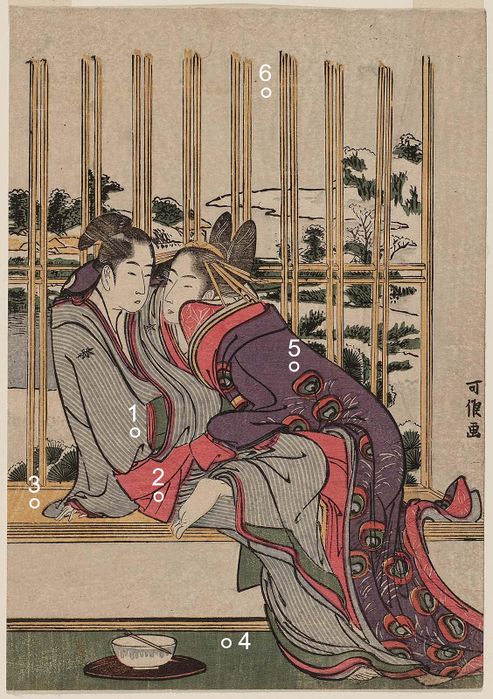Ukiyoe EDO-LIFE: Riverside Sawmill
Workers at a sawmill use the latest tools and their honed skills to prepare the building blocks of Edo life: long, narrow beams, bamboo stems and leftover wood stacked as high as buildings.
本所立川
編 號 : Hokusai
˙畫名:本所立川 The timberyard at Honjo
˙作者:葛飾北齋
˙年份:1830 年
˙尺寸:66 x 100 cm
首頁/ 藝術家 / 江戶( 1603 – 1867 年) / 葛飾北齋/ 本所立川
2021 年 3 月 21 日 ·
分享到:
阿什莫林博物館
2021 年 3 月 21 日 ·
今天是世界詩歌日!
Surimono 詩歌版畫是 19 世紀早期日本木版畫最精美的典範之一。它們由詼諧的詩歌和相關圖像組成,通常由頂尖的印刷藝術家設計,並使用現有的最佳材料和技術印刷而成。
這幅版畫描繪了一對陽台上的年輕戀人。精緻的五官和女性化的服飾表明左邊的人物是一位「wakashu」——尚未經歷日本傳統成年儀式的年輕男孩。
這幅版畫中的詩是一首 17 音節的俳句,翻譯過來就是......「一個年輕女子和一個和歌集,他們的愛情像削好的鰹魚花一樣萌芽」。
鰹魚是個意想不到的詞,它指的是日本料理中常用的乾魚片。它們呈半透明狀,顏色淡淡的,看起來就像嬌嫩的花瓣,在與其他成分接觸時綻放。這種家庭而又優雅的典故似乎完美地捕捉了親密的氛圍。
現在人們認為這幅 surimono 印花是偉大的日本設計師 Hokusai 的作品,大約創作於 18 世紀。 1790 年至 1830 年。
Hanching Chung
Hokusai, Lingering Snow for Azuma and Yohei, from the untitled series known as Eight Views of Tragic Lovers, 21.10195
Lingering Snow for Azuma and Yohei (Azuma Yohei zansetsu), from the untitled series known as Eight Views of Tragic Lovers (Michiyuki hakkei)
道行八景 あづま 与平 残雪
Katsushika Hokusai (1760–1849)
Edo period about 1798 (Kansei 10)
Other impressions: 11.20160
for more information see:
MFA Online Collections Database
Summary
| Analysis point | Image | Methods | Results |
|---|---|---|---|
| Pt 1 | XRF, EEM, FORS | dayflower | |
| Pt 2 | XRF, EEM | madder | |
| Pt 3 | XRF, EEM | turmeric | |
| Pt 4 | XRF, EEM, FORS | flavonoid, indigo | |
| Pt 5 | XRF, EEM, FORS | dayflower, safflower | |
| Pt 6 | XRF, EEM | (sumi) |
Note: The center of the circle is point of analysis. For information on the analytical methods, see More on the data.









沒有留言:
張貼留言